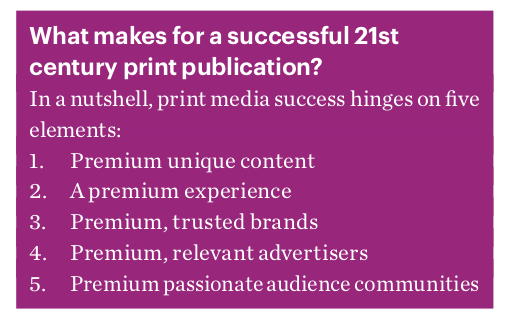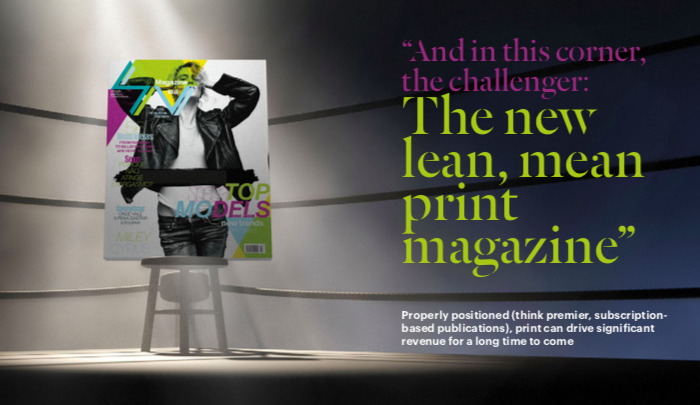
19 Nov “And in this corner, the challenger: The new lean, mean print magazine”
Properly positioned (think premier, subscription-based publications), print can drive significant revenue for a long time to come.
Duck!
Here comes the print pendulum, screaming back with speed and long-lost momentum.
It’s coming back a lean, mean, laser-focused magazine machine.
“New Print” is leaner not just because the old print business model was brutally treated (which it was), but also because that ravaging trimmed a lot of the blubber that once passed for meaningful reach.
The “new print” business model is in fighting trim to be able to compete in the 21st century digital publishing environment where successful print publishing must be obsessed with delivering exclusive content and a premium experience to smaller, select, lucrative, premium paying audiences.
“New print” practitioners understand print’s new role and they are already creating solid success stories.
But the “new print” model is also dangerous. Print publishers who fail to adapt to the new print reality are ultimately doomed. Almost every print publisher can make the transition to the profitable new model by offering exclusive content to a community of shared interests in the tactile, finite, elegant, quiet experience that digital simply cannot replicate.
But it won’t be easy.
For some publishers, this transformation to the new print world will require a wrenching retooling of everything they do, including their mission, products, processes, and personnel. For other, more advanced publishers, it may mean focusing on smaller but more targeted audiences. It could mean launching new products around the passions of their audiences.
For still other publishers, it could mean closing much-beloved legacy print products and replacing them with more targeted, more niche, more exclusive, reader-funded print publications.
With print still providing the majority of revenue for many legacy operations, publishers must resist the temptation to stand pat out of fear of jeopardising what’s left of print advertising income. Publishers must act now to ensure the transition of their print products to their new role in the digital world rather than ride a slowly dying horse until it expires under them.
Print success right under our noses
Doomsday predictors dominated the future-of-the-industry discussions over the last decade or so with statistics documenting the un- deniable structural change in publishing. There is no need to rehash those numbers or “Print Is Dead” headlines.
But what escaped the notice of the doomsday disciples was a hidden but healthy substrate of print publishers who had managed to actually thrive in what was otherwise a print Armageddon.
Fortunately, those publishers, as well as some startups and legacy publishers who’ve figured things out, are providing many examples of how print can profitably thrive in a world dominated by digital.
Additionally, something the naysayers couldn’t have known until recently is that the next generation of readers — the Millennials — would embrace print in greater numbers than their parents and grandparents, according to multiple studies (see the sidebar on Millennials reading print).
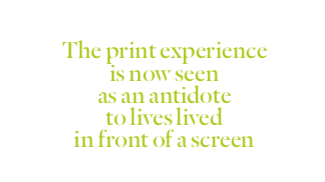
The basics of print success
So, what are the common denominators of print success, and who are the poster boys for 21st century print publishing?
All of print’s age-old advantages still apply — print is still that wonderful tactile, sensory, focused, quiet, exquisitely presented, lasting, memorable experience that those of us who grew up before the internet took over — and many print-lovers since — remember.
But now, in addition to print’s ageless advantages, the digital experience itself has become a selling point for print. Digital has lost some of its shiny new-thing lustre. Its warts are not only showing but are also increasingly irritating users. As a result, users are looking for alternatives to reading online.
Why? Unlike the digital reading experience, print readers cannot be interrupted or have their reading experience ruined by the bêtes noires of the digital age: pop-up ads, text messages, battery failure, sunlight on screens, loss of wifi, etc. Print content also cannot be deleted or lost due to a computer shut-down.
The print experience is also now seen as an antidote to lives lived in front of a screen. Surveys have found that readers, especially Millennials, love their print magazines because the print experience represents an escape from everything digital (see Millennials sidebar).
Ironically, the very success of the internet is undoing some of the internet’s success.
What was once seen as a wealth of online content has now become an uncharted, over- whelming miasma of questionable, even false and offensive information.
What was once a tantalisingly global ad market has become an unregulated jungle of fraud, unsavoury placements, unseen ads, and more.
And what was once seen as a wonderful world of social connections has become an intrusive often unpleasant invasion of privacy — a bullying, polarising disruptor of a peaceful life. Thanks to a lack of transparency and meaningful data on the part of publishers and platforms, brands and agencies have been driven to demand (mostly unsuccessfully) useful metrics and transparency.
Those brands and agencies are even beginning to doubt just how well digital advertising works and whether they might have been spending too much for too little return online while shortchanging other media in the process.
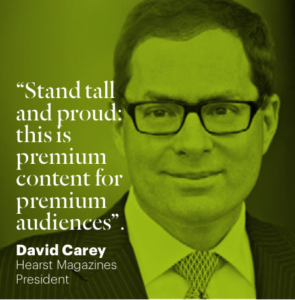 The digital ad world is plagued by “substantial waste in a fraudulent media supply chain,” Procter & Gamble (P&G) CMO Marc Pritchard told attendees at the 2017 global business and innovation conference DMexco. “The reality is that in 2017 the bloom came off the rose for digital media. As little as 25% of the money spent in digital media actually made it to consumers.” To make its point, P&G cut online advertising dramatically in 2017 and reportedly saw no impact on results. The consumer goods group cut $US100 million in digital marketing spending and actually saw an increase in sales, according to the company’s mid-2017 earnings report.
The digital ad world is plagued by “substantial waste in a fraudulent media supply chain,” Procter & Gamble (P&G) CMO Marc Pritchard told attendees at the 2017 global business and innovation conference DMexco. “The reality is that in 2017 the bloom came off the rose for digital media. As little as 25% of the money spent in digital media actually made it to consumers.” To make its point, P&G cut online advertising dramatically in 2017 and reportedly saw no impact on results. The consumer goods group cut $US100 million in digital marketing spending and actually saw an increase in sales, according to the company’s mid-2017 earnings report.
“This is our moment in time because everything that marketers need to be effective… in this age of confusion about media companies and what they represent and who you can trust, it all points back to magazine media,” Linda Thomas Brooks, CEO of the MPA – The US Association of Magazine Media, told the Australian Financial Review.
Citing the results of the P&G spending cut, she said: “What does that tell you about the efficacy of what they’re doing? It’s not going to rewind the world to 15 or 20 years ago but we do hear advertisers saying they’re looking to spend more in print.”
“The more noise there is on social media… the more demand there is for a finite, finishable package that helps you understand what’s going on,” The Economist Deputy Editor Tom Standage told The New Statesman. “A noisier and more uncertain news environment works in our favour.”
Caveat emptor
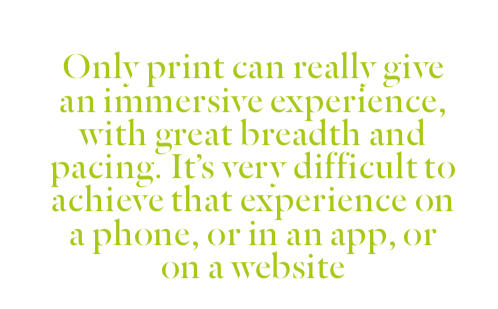
Before we get too excited about the return of print, we should make it crystal clear that print will not be coming back to the levels of revenue it enjoyed before.
Worldwide digital ad spending will reach $223.74 billion in 2017 to represent 38.8% of total paid media outlays, while print will continue to decline, according to eMarketer. Magazines will drop from 5.8% to 4.3% of total paid media, according to Zenith, the ROI agency.
But that’s OK. That is still a very large chunk of change.
Media consultant Bo Sacks likes to point out that he saw this coming way back in 2012 when he wrote in his “Heard on the Web: Media Intelligence” newsletter: “Print isn’t dead or dying; it is evolving from a commodity to a luxury. As a luxury, there will be much less of it, but what is left will be of extremely high quality in both the physical product and the editorial content.
“Businessmen and venture capitalists mistake a change in dominance for death,” Sacks wrote. “Loss of dominance is not equivalent to death; it just looks and feels that way after 600 years of supreme domination.
“The facts are the facts: There are billions being made every day in print, and there will be billions made in print for the foreseeable future,” Sacks predicted. “Yes, printed products will take a serious back seat to the digital communication business, because at the end of the day digital is and will be faster, timely, profitable and ubiquitous.”
1. Premium unique content
Information easily and freely obtained elsewhere (obtained with a quick Google search) is a non-starter in print. “People are more acute than ever about sniffing out cloned content,” former media executive Colin Morrison told the now-defunct Media Briefing. “Magazine content needs increasingly to be valuable and exclusive: what do you have that no one else does?” Morrison was CEO of international media companies for: Reed Elsevier, EMAP, Australian Consolidated Press, Axel Springer, Future, and Hearst, in the UK, Australia and Continental Europe.
2. A premium experience
If we’re going to charge a premium price, we have to offer a premium experience. That means premium paper, premium photography, premium design, premium advertising experiences. “It (a magazine) is a different experience — it’s premium,” New York Media CEO Pam Wasserstein told the 2017 MPA American Magazine Media Conference. “Facebook is good at targeting, but it’s not necessarily a premium experience.”
“Stand tall and proud: this is premium con- tent for premium audiences,” Hearst Magazines President David Carey urged the same audience.
“We’re seeing a renaissance in print titles — particularly design and women’s titles which are intentionally luxurious, in beautiful high-quality paper, and priced at a luxury price point,” J Walter Thompson director Lucie Greene told The Guardian. “The Gentlewom- an, Riposte and Cherry BombBombe are all examples of print titles that make print a luxury experience, something slow, not disposable, and considered.”
3. Premium, trusted brands
Canada’s Marketing magazine polled consumers to understand what they expect from a premium media experience. Of the elements that made a reading experience prestigious, the top factor was that the publication be a trusted source for information (79%).
Quality and trust matter more than ever before, and with magazine media presenting “carefully researched, well-written, and masterfully edited and curated content”, publishers are in a strong position to voice their differentiation in the marketplace and capture opportunities available, the MPA’s Thomas Brooks told FIPP.com.
“Why are these local luxury design magazines growing in ad pages and thumping when they hit the table?” Esteem Media CEO Adam Japko told Folio. “If a media brand has a following and is highly recognisable, then it’s like a club.”
4. Premium, relevant advertisers
“The ads in print can have an aspirational, escapist capacity with exotic locations, beautiful people, plush interiors. Magazine adverts specialise in presenting an audience’s dreams and desires, and who doesn’t enjoy that?” in-flight publisher Ink CEO Simon Leslie told FreeportPress.
Leslie cites Condé Nast’s Nicholas Coleridge as saying, “It is very hard to replicate the physical allure of a luxury magazine on other platforms… It’s something to do with the sheen of the paper, the way that the ink sits on the page, the smell of money and desire that wafts off the page. Readers move into a different mode when they engage with a glossy magazine. Advertisers understand this.”
That Canadian reader survey mentioned earlier also found that when it came to considering a publication and its advertisements prestigious, 76% cited exquisite design of stories and advertisements.
5. Premium passionate audience communities
When he was considering launching a print product targeting the 48% of UK citizens who voted against Brexit, New European Editor Matt Kelly knew he had to target a premium, passionate audience. “If there was ever a time for a new newspaper, it was now, because I couldn’t see which newspaper reflected the views of the 48%,” Kelly told FIPP.com. “Print has very real assets that digital doesn’t, and they were particularly relevant to this situation. The idea that you could carry it around and show other people what you were aligned with.”
Being a member of a premium or community is something its members want to tout, Northwestern University professor Stephanie Edgerly told Politico. “This is why the NPR tote bag is a big deal, this is why the New Yorker had a tote bag that was viewed as a hot commodity.
“[A brand] stands for certain types of values you want to associate yourself with and that becomes even more important in this political climate,” she said.
“By values, I don’t want to just mean liberal, conservative, Democrat, Republican,” she said. “It’s a lot more complex than that. These stand for lifestyle values, these stand for how you see yourself.”
“News is disposable and has a lifespan, but niche content focused on other interests and hobbies is more likely to be retained and print is the perfect format for that,” former magazine executive Robert Grainger wrote in Publishing Executive. “Assume that certain content is disposable, while some content suits being retained and cherished, understand the difference and it becomes easier to see a healthy future.”
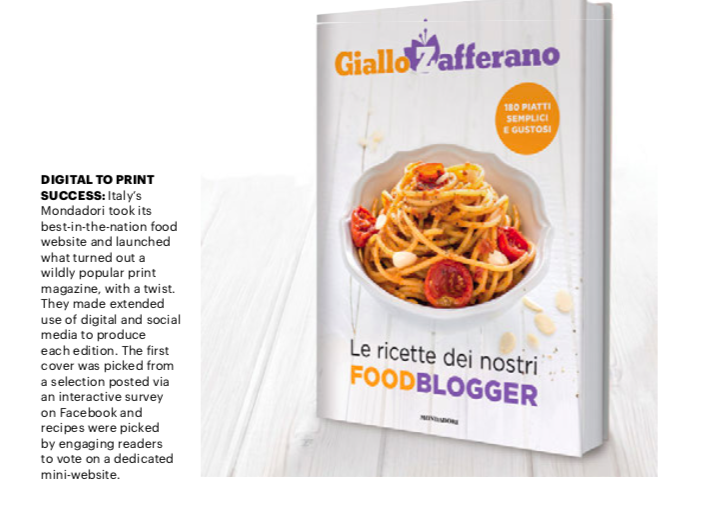
Examples of print success: Digital to print
They say you can’t teach an old dog new tricks. But here’s one greybeard legacy publication company’s very successful new trick: Italy’s Mondadori took its best-in-the-nation food website and launched what turned out to be a wildly popular print magazine, with a twist.
Looking at the millions of readers using their Giallo Zafferano food website, the management team decided to roll the dice and launch a print product for that same audience.
At the time (Dec. 2016), the site had 6.8 million monthly unique visitors, including 600,000 who used the site every day, a rate five times their nearest competitor, according to Carlo Mandelli, Chairman and CEO of Mondadori International Business. Their social media popularity was equally robust with 4.9 million active fans on its fan pages and 12,000 bloggers writing on Mondadori’s dedicated food blogging platform.
“With the strong brand awareness and audience engagement of Giallo Zafferano. It combined with Mondadori’s extensive expertise in the food magazine segment — we already publish five magazines in this sector — we knew that the Giallo Zafferano brand offered a huge opportunity,” Mandelli told us.
“We made extended use of digital and social media to produce each edition,” Mandelli said. “Our cover was picked from a selection posted via an interactive survey on Facebook and recipes were picked by engaging readers to vote on a dedicated mini-website.
“Through the use of augmented reality we also provided our readers a more immersive experience by offering videos of how the recipes we featured in the magazine are actually prepared,” Mandelli told us.
“Our first magazine in March 2017 sold 410,000 copies, with a positive margin, and our future circulation targets are 200,000 copies per edition,” he said.
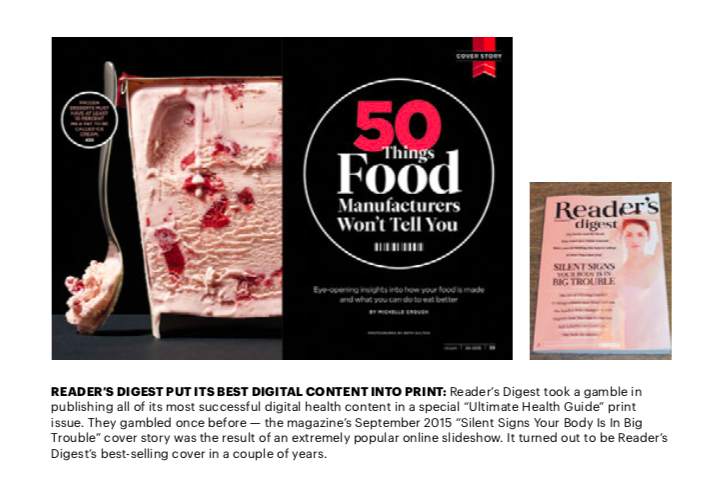
Reader’s Digest puts its best digital content into print
If people are passionate about a subject, will that passion drive them to purchase content they’d already read online if it was beautifully assembled in a keepsake print edition?
That was the gamble Reader’s Digest took in publishing all of its most successful digital health content in a special “Ultimate Health Guide” print issue.
“We know that our monthly multichannel audiences of nearly 27 million have an incredible passion for our health and wellness information,” Chief Content Officer Bruce Kelley told Media Post. “Based on research with these audiences, we believe there is a strong appetite for this information in a highly curated print-only edition. “My thinking is we use the web to really figure out what people most care about and then give it to them in magazine form as well,” he said.
Given Reader’s Digest experience with the “digital-to-print” method, this edition wasn’t as big a gamble as it might have appeared. The magazine’s September 2015 “Silent Signs Your Body Is In Big Trouble” cover story was the result of an extremely popular online slideshow. It turned out to be Reader’s Digest’s best-selling cover in a couple of years, Kelley said.
“We kept rolling out that franchise online until we had published dozens of articles on ‘Silent Signs You May Have… ’ that became the basis for that special newsstand issue,” he said.
The “Ultimate Health Guide” had a circulation of about 400,000 and a cover price of $4.99.
Examples of print success: Print-only launches
The New European launched as a print-only, paid-circulation weekly newspaper in July 2016 in response to the Brexit vote in the UK. The editorial team at UK publisher Archant thought there should be a newspaper for the 48% of the UK population who’d voted “no”. Despite some misgivings, Editor Matt Kelly and the Archant team built and launched the first edition in nine days.
Initially, publisher Archant planned only four issues. But when it sold 40,000 copies of the third issue, Archant decided to continue publishing. In late 2016, circulation had levelled off at a steady 23,000, according to Circulation Director Darron McLoughlin. The paper has only four full-time staff and 25 regular contributors. It has expanded it digital presence significantly, attracting a reported 1 million unique monthly visitors, according to the company.
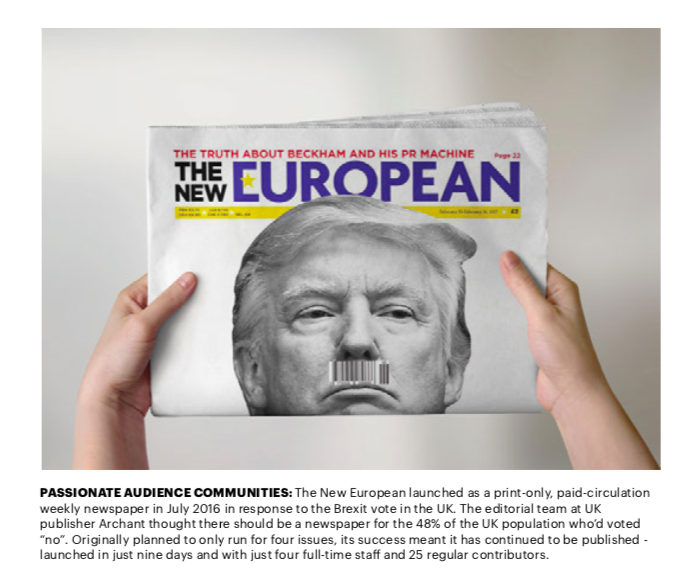
“I’d always been struck by the concept of a newspaper or a printed media being a form of visible demonstration of what you are,” Kelly told FIPP.com. “I was very determined that we kept the price as high as we could, because I never thought the price point was going to be the defining factor in this paper’s success. I thought how well we nailed the spirit of the audience was going to be the defining factor. I wished we’d charged a fiver [£5] for it now as I really don’t think it makes a difference to the audience, as the people who buy it, get it completely and they love it. The people who don’t, couldn’t give a shit about it, so the price isn’t the main point.”
Examples of print success: Legacy print launching niche print publications
The Week’s outrageous success with kids: In late 2016, The Week’s team decided to act on reader data showing that kids in its subscribers’ homes were readers, too.
“The perceived wisdom suggested that children read digital products, they had little interest in the news, and that it’s solely video content they want,” Kerin O’Connor, Chief Executive of The Week at Dennis Publishing, told us. “But when we dug further into this audience, we found that UK children’s books sales were at a 10-year high.”
So O’Connor and his team set about to create a version of The Week that would resonate with nine- year-olds : The Week Junior. “We couldn’t produce a dense digest of news with small pictures and sell it to a nine year old,” O’Connor told FIPP.com. It had to appeal to kids, their parents, and their teachers.
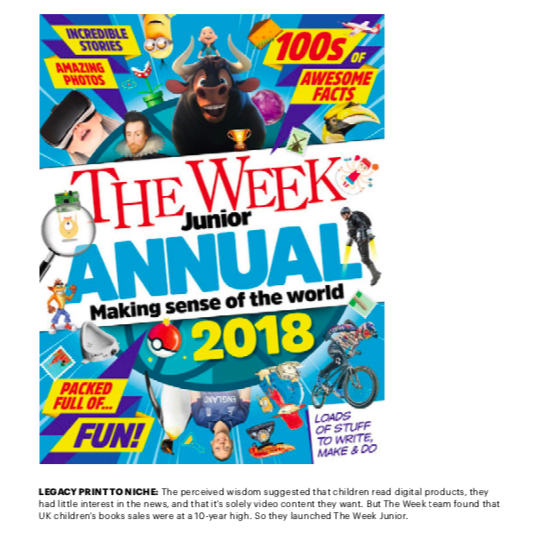
“A core idea for The Week Junior was ‘making sense of the world’ — giving them confidence in their own opinions and ability to be look at a wide range of subjects,” said O’Connor.
To do this, they chose print. “Only print can really give an immersive experience, with great breadth and pacing,” O’Connor told us. “It’s very difficult to achieve that experience on a phone, or in an app, or on a website. Also print is universal — not all nine-year-olds have iPhones. And we know that lots of our readers like to keep the copies. They’re also easier to share within the family or discuss editorial with parents. One final thing, the quality is higher because the pictures look better.”
The result?
“Our renewal rates are already equivalent to The Week, which is a mature product,” O’Connor said. “More importantly for a launch, our take through rates, which is the calculation of how many people pay up on trials, are more than double our best-performing other magazine.
“It’s the fastest-growing subscription magazine that Dennis has ever published, about twice as fast as anything we’ve seen before,” O’Connor told us.
Meredith’s new Magnolia Journal rides celebrity appeal to 1.2m copies in a year
“We knew (Chip and Joanna) were popular, we knew they were kind of the darlings of their space, but we also understood most of their content had been free to the consumer, and we wanted to see if the consumers would pay a premium for a product that we put out there in their name, Meredith Senior Vice President/ Publisher Christine Guilfoyle told FIPP. “Luckily for us, they were willing.”
Their fans were not just willing but wild. Meredith Publishing had an inkling that the two stars of the “Fixer-Upper” show on Home and Garden Television (HGTV) might be able to translate their fame to print.
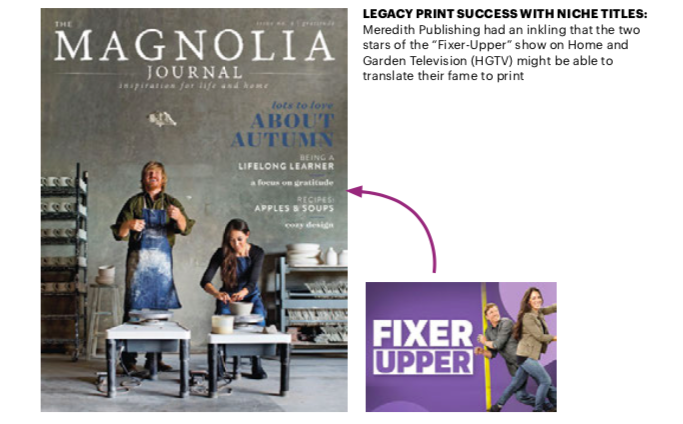
And that’s despite a relatively steep price: US$7.99. The first is- sue, Fall 2016, went on sale with 400,000 copies at newsstands and major retailers across the US. Within two weeks, they had to print an additional 200,000 copies. In late 2017, just a year later, Meredith announced that the first print run in 2018 would be 1.2 million. Equally impressive, they are charging a premium price (US$7.99) and, according to the company, selling through 70%, compared to the industry average of 25%.
“We’ve learned that the consumer is completely and utterly in charge if you give them a product that speaks to a passion point,” she told us. “Another lesson we’ve learned is to apply all of our best analytics and learnings that we’ve accumulated over the last 100 years of our business, but also be open to trying new things and come to each project with a fresh perspective.
“This is a five-star example of print is alive and well, and thriving,” Guilfoyle said.
Spotting an opening: Monocle’s summer-only print magazine
Monocle’s team approached summer differently in 2017. It didn’t take a genius to realise that most if not all of Monocle’s readers left town for four to eight weeks heading for some pretty chill places.
It did take a genius to suggest a pop-up publication to reach their readers where they were relaxing. Give them a Monocle-style summer newspaper. This was “a time of year when people have the luxury and time to read,” and when advertisers are looking to target Europeans on holiday, according to Monocle Founder and Editor-in-Chief Tyler Brûlé.
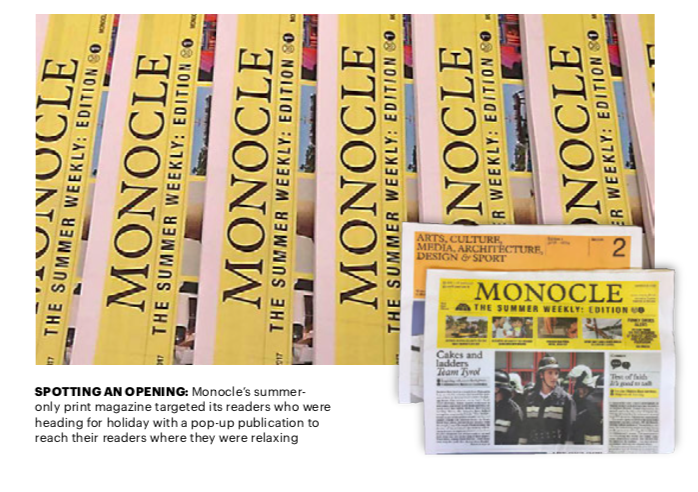
Printed on high-quality paper, each edition featured all the elements you’d expect in a good- read magazine designed to keep readers apace of developments back in the real world: in addition to global news, the three-section paper featured food, wine, fashion, sport, arts, culture, business, architecture, design, and opinion. All written in the unique Monocle style.
Monocle readers not wanting to take a chance on finding it at the newsstand in their holiday town could pre-order, and hundreds did. Together with the pre-orders, pre-launch ad sales made the project profitable before the first edition rolled off the presses.
Examples of print success: Niche titles
“The thing is: print is not only profitable, it is extremely profitable for us!” Leif Jonasson, Editor-in-Chief of four Bonnier Publications computer titles, told us. Jonasson’s titles still pull in the bulk of their revenues from print magazine subscriptions. “There are some apps and digital products but 90% of our business is still print,” Jonasson said. “We have a market segment where customers are willing to pay quite a large amount for their magazines.
“It’s interesting that for so many publishers the website is at the centre, but for us it is more of a supplement,” said Jonasson. “What we are beginning to establish now is that new news about hardware, computers, or tablets, is published to the website as soon as it is announced. But the magazine will provide a lengthier and ultimately more informative piece on that story, which is important particularly in areas of specialist interest content.
“We want to make sure that our readers get the impression that what they are paying for now is not only a magazine but also a package: high-quality print content, but also a lot of digital add-ons, too,” Jonasson said.
Print successes: Tying print to digital
If digital is the dominant method of information consumption, why not pair print with digital for the best of both worlds? And, given the burgeoning popularity of artificial intelligence, why not jump on that bandwagon at the same time? Conde Nast’s Vogue magazine teamed up with Google Home, a voice-activated home speaker system that lets its users ask questions verbally.
Readers in the US of Vogue’s 125th Anniversary edition in September 2017 who had a Google Home device could ask it for more information on any one of five articles. All the reader had to do was say something like “Hey Google, ask Vogue to tell me more about Jennifer Lawrence.” Instantly, Google Home would start talking about the cover story interview with the actress.
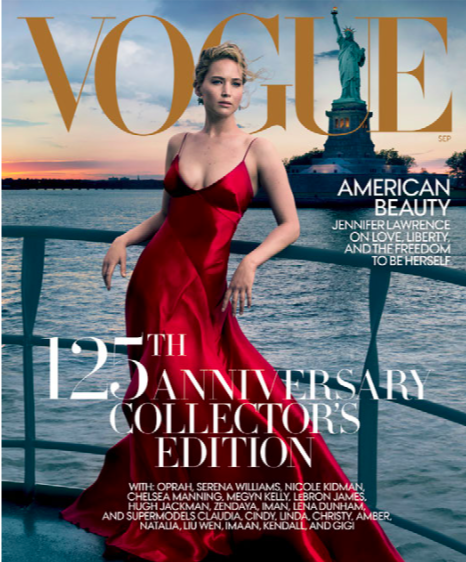
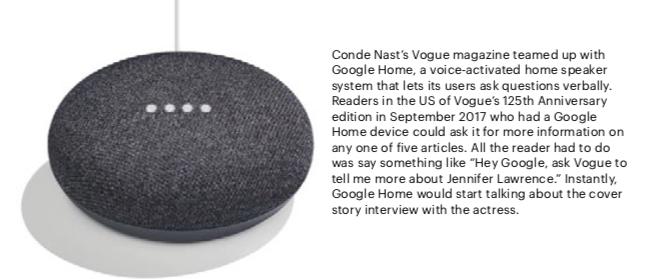
Forbes also paired a print edition with digital enhancements. For that magazine’s 100th anniversary issue in September 2017, the cover headline invited readers to “Ask Warren (Almost) Anything”. By taking a picture of that cover and going to a dedicated Forbes website, readers could ask the famous businessman questions about investments and wealth and life. The answers, of course, did not come from the actual Warren Buffet, US business magnate, investor, and philanthropist, but from a pre-programmed set of 33 pre-recorded replies created in anticipation of the types of questions readers might ask.
The outlook for print
So, with those bits of inspiration, what does the print future look like now?
New European Editor Kelly sums it up pretty neatly, especially for a guy who’s spent the last 15 years trying to get media companies to move to digital.
“Much legacy media is built along fault lines that are no longer relevant to people’s lives and this erosion of newspaper and magazine sale that we’re seeing is possibly in-part because in truth those products no longer reflect this,” he told FIPP.com.
“If you can’t reinvent your own brand based on what you honestly believe to be true about your audience, then you are in a death spiral,” he told us. “But if you can take a step back and say, ‘Do you know what? We just need to objectively think about what our audience really cares about, not what we have been peddling them for the last 20 years, and start afresh, either under your own brand or a new brand, then I think you can really re-invigorate your product.”
We agree.
